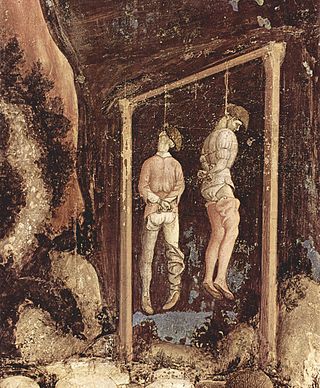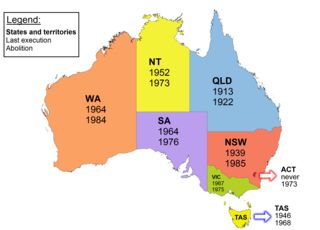
Hanging is killing a person by suspending them from the neck with a noose or ligature. Hanging has been a standard method of capital punishment since the Middle Ages, and has been the primary execution method in numerous countries and regions. The first known account of execution by hanging is in Homer's Odyssey. Hanging is also a method of suicide.

Albert Pierrepoint was an English hangman who executed between 435 and 600 people in a 25-year career that ended in 1956. His father Henry and uncle Thomas were official hangmen before him.

Capital punishment in the United Kingdom predates the formation of the UK, having been used in Britain and Ireland from ancient times until the second half of the 20th century. The last executions in the United Kingdom were by hanging, and took place in 1964; capital punishment for murder was suspended in 1965 and finally abolished in 1969. Although unused, the death penalty remained a legally defined punishment for certain offences such as treason until it was completely abolished in 1998; the last person to be executed for treason was William Joyce, in 1946. In 2004, Protocol No. 13 to the European Convention on Human Rights became binding on the United Kingdom; it prohibits the restoration of the death penalty as long as the UK is a party to the convention.

Capital punishment was abolished via the legislative process on May 2, 2013, in the U.S. state of Maryland.
Capital punishment is one of two possible penalties for aggravated murder in the U.S. state of Oregon, with it being required by the Constitution of Oregon.
Capital punishment in Canada dates to Canada's earliest history, including its period as first a French then a British colony. From 1867 to the elimination of the death penalty for murder on July 26, 1976, 1,481 people had been sentenced to death, and 710 had been executed. Of those executed, 697 were men and 13 women. The only method used in Canada for capital punishment of civilians after the end of the French regime was hanging. The last execution in Canada was the double hanging of Arthur Lucas and Ronald Turpin on December 11, 1962, at Toronto's Don Jail. The National Defence Act prescribed the death penalty for certain military offences until 1999, although no military executions had been carried out since 1946.

Capital punishment – the process of sentencing convicted offenders to death for the most serious crimes and carrying out that sentence, as ordered by a legal system – first appeared in New Zealand in a codified form when New Zealand became a British colony in 1840. It was first carried out with a public hanging in Victoria Street, Auckland in 1842, while the last execution occurred in 1957 at Mount Eden Prison, also in Auckland. In total, 85 people have been lawfully executed in New Zealand.

The Don Jail was a jail in Toronto, Ontario, Canada, located to the east of the Don River, on Gerrard Street East in the Riverdale neighbourhood. The original building was completed in 1864 and was reopened in 2013 to serve as the administrative wing of Bridgepoint Active Healthcare, a rehabilitation hospital located adjacent to the jail. Prior to its adaptive reuse as part of a healthcare facility, the building was used as a provincial jail for remanded offenders and was officially known as the Toronto Jail. The jail originally had a capacity of 184 inmates, and it was separated into an east wing for the men and a west wing for the women.
Capital punishment is a legal penalty in Sri Lanka.
Capital punishment in Iraq is a legal penalty. It was commonly used by the government of Saddam Hussein, was temporarily halted after the US-led 2003 invasion of Iraq that deposed Hussein, and has since been reinstated. Executions are carried out by hanging.

Capital punishment in Australia has been abolished in all jurisdictions since 1985. Queensland abolished the death penalty in 1922. Tasmania did the same in 1968. The Commonwealth abolished the death penalty in 1973, with application also in the Australian Capital Territory and the Northern Territory. Victoria did so in 1975, South Australia in 1976, and Western Australia in 1984. New South Wales abolished the death penalty for murder in 1955, and for all crimes in 1985. In 2010, the Commonwealth Parliament passed legislation prohibiting the re-establishment of capital punishment by any state or territory. Australian law prohibits the extradition or deportation of a prisoner to another jurisdiction if they could be sentenced to death for any crime.

Arthur Lucas, originally from the U.S. state of Georgia, was one of the last two people to be executed in Canada, on 11 December 1962. Lucas had been convicted of the murder of 44-year-old Therland Crater, a drug dealer and police informant from Detroit. He is also assumed to have killed 20-year-old Carolyn Ann Newman, Crater's common-law wife, but was never tried in her death. Crater was shot four times, while Newman was nearly decapitated. The murders took place in Toronto on 17 November 1961.
Capital punishment was abolished in Colorado in 2020. It was legal from 1974 until 2020 prior to it being abolished in all future cases.

Capital punishment was outlawed in the State of New York after the New York Court of Appeals declared that the statute as written was not valid under the state's constitution in 2004. However certain crimes occurring in the state that fall under the jurisdiction of the federal government are subject to the federal death penalty.

John Robert Radclive was Canada's first professional hangman, serving from 1892 until the early 20th century.
Capital punishment is a legal penalty in Jordan. The country had a moratorium on capital punishment between 2006 and 2014. In late 2014 the moratorium was lifted and 11 people were executed. Two more executions followed in 2015, 15 executions took place in 2017 and one in 2021. The method of execution is hanging, although shooting was previously the sole method for carrying out executions.
Capital punishment in Minnesota was abolished in 1911. Between 1854 and Minnesota's final execution in 1906, at least 70 people were executed in the Minnesota Territory and the State of Minnesota, all by hanging.
Capital punishment has never been practiced within Alaska throughout its history as a state, as it was abolished in 1957. Between December 28, 1869, and April 14, 1950, between the Department, District, and Territory of Alaska, twelve felons, all male, were executed by hanging for murder, robbery, and other crimes. Some were European, some were Native American, and two were African. The territorial legislature abolished capital punishment in 1957 during preparations for statehood, making Alaska the first in the West Coast of the United States to outlaw executions, along with Hawaii, which did the same.










